A few weeks ago, I reviewed Kathy Shaw’s new book, Stunning Stitches for Crazy Quilts. You can read that review here.
When I wrote about this little stitch sampler needlebook, I received quite a bit of feedback about the difficulties of keeping stitches and lines straight and consistent. With my little sampler, I used the linen to guide my lines and keep them straight, but we don’t always work on fabric with an easy-to-see weave.
And that’s where these embroidery stitch templates designed by Kathy Shaw and distributed by Creative Impressions come in handy. I thought I’d show them to you today, in case they are something that can benefit you in your embroidery journey. I’m going to explain what they are, how they’re used, and share some pros and cons with you.
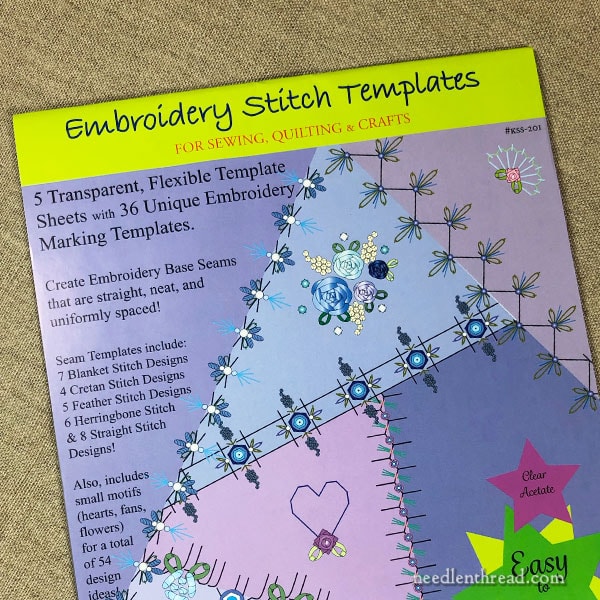
Embroidery Stitch Templates come in a package of six clear acetate sheets that can be cut down into strips by following the guidelines on the sheets.
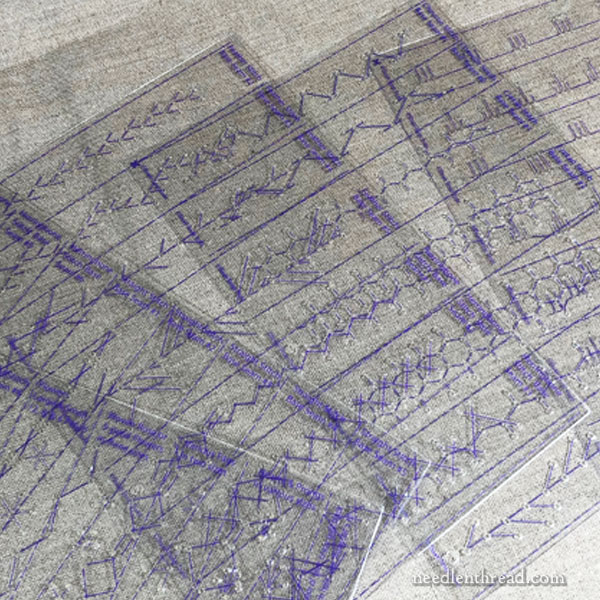
All in a heap, this is pretty much what they look like.
The sheets are sectioned off into horizontal strips, and within each horizontal strip is a stitching layout marked by blue lines.
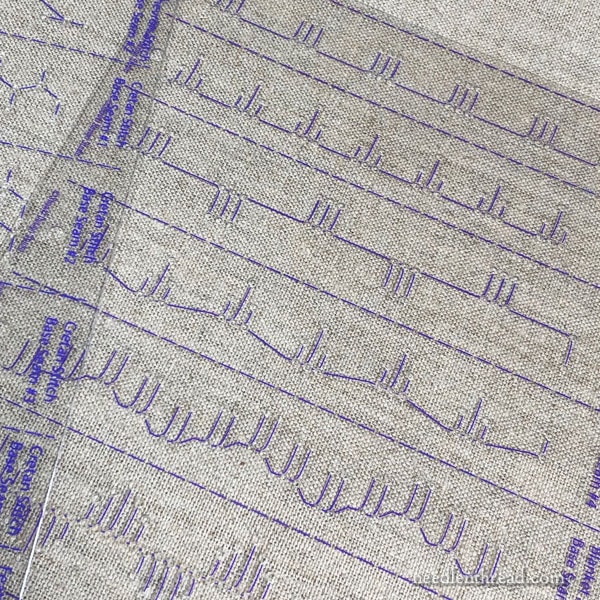
The templates are organized by stitch family, so each group of decorative lines – all of which make for great crazy quilting seams or sampler-developing on larger stitch samplers – centers around one basic stitch.
For example, in the photo above, that group of templates on that page all belong to the buttonhole stitch family.
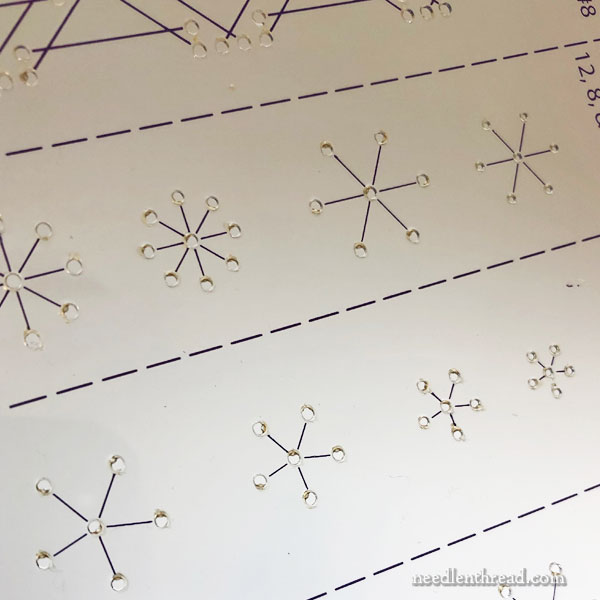
Not all the templates are linear – there’s a page of templates with individual elements, too.
If you’ve ever had difficulty keeping flower petals consistent and even, this is a great way to assist with that!
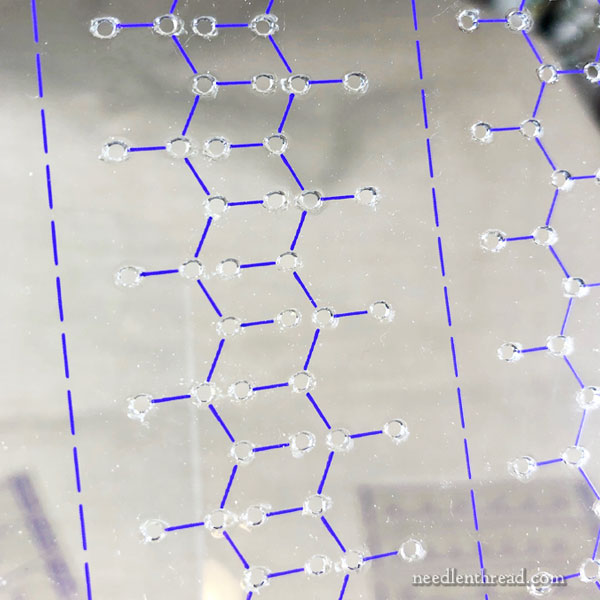
So how do they work?
As you can see in the photo above, each template consists of blue lines and open holes. The open holes are placed everywhere your needle would enter and exit the fabric when stitching that particular configuration of a line.
You place the clear template over your crazy quilt seam or onto any fabric (they can be used for other embroidery endeavors, too), and, using a pencil or fabric marker, you dot the fabric through the holes in the template.
Then, you stitch the line by following your dot pattern that’s left on the fabric.
Simple!
Pros & Cons
Like any product, there are pros and cons to the stitch templates.
The pros are pretty obvious:
- You can easily and quickly mark a line for embroidery using the templates, ensuring a consistent, even line of stitching that can be further embellished.
- The clear acetate ensures that your templates will last a long time.
- The grouping by stitch family helps keep things organized and helps the beginner develop a feel for what each stitch can do.
- For people who have difficulty maintaining straight lines and consistently sized stitches, these practically guarantee success.
They’re excellent for beginners who need to get a feel for stitching straight lines and even stitches. They’re excellent for beyond-beginners who want to play with building embellished foundation lines of stitches, especially for crazy quilting, but also just for the fun of it.
And they are excellent for folks who suffer from eyesight problems that make it hard to see the weave of the fabric and to judge distance and size when stitching. The dots are a sure guide to help you see where to go with your needle and thread.
There are a couple sort-of cons:
The acetate templates are somewhat expensive at first glance. They run about $30, which makes each page about $5. But there are over 50 templates and design ideas, on a material that will last a lot longer than paper.
The templates are designed primarily for crazy quilting, so the stitch layouts are somewhat large. If you’re expecting to stitch finer lines on a little sampler, for example, they won’t work as well for that. But who’s to say a sampler has to be small?
Where to Find Them
Creative Impressions sells these Embroidery Stitch Templates directly on their website. Shop owners can contact them about wholesale ordering, but retail customers can shop on the website, too. You’ll need to go to the shop section and search “embroidery stitch templates.” I couldn’t find a direct link to the product.
They also sell them through Amazon, and you can find them under Tools & Accessories on my Amazon Recommendations Page. I’ve tried to organize that page a bit, by dividing it into stitching tools & accessories and needlework books. I’m hoping that makes it easier for you to browse?
Coming Up on Needle ‘n Thread
I’m trying to quickly finish the samples for my local youth classes this summer, which start at the end of July. I’ll show those to you and share some reflections. It doesn’t matter how simple a project is, I always learn something from it!
I’ll be working on The Leafy Tree instructions all weekend. As you know from this article, I’ve been working on the kit – just on one more component needs to arrive, to finish assembling those. Look for a mid-July (or earlier) launch on that – keep an eye out for more information.
During July, my brother will be helping me with some technical stuff, which will result in some Good Things for Needle ‘n Thread readers. I’m pretty excited and can’t wait to share new stuff with you that will enhance your embroidery journey.
I hope you have a wonderful weekend with your needle and thread!
This article contains an affiliate link to my Amazon Recommendations page, which means that any purchases made through that link result in a small commission for Needle ‘n Thread with no extra cost to you. Thanks for your support!